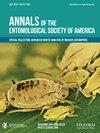长角甲虫的触角感受器(鞘翅目:天牛科)
IF 1.8
3区 农林科学
Q1 ENTOMOLOGY
引用次数: 0
摘要
昆虫的触角是重要的感觉器官,它容纳了许多感受器,这些感受器可以感知支配它们世界的各种各样的线索。历史上,不一致的术语和标准被用于对触角感觉器进行分类,这极大地阻碍了数据的比较,甚至在密切相关的物种之间。长角甲虫(鞘翅目:天牛科)也不例外,尽管它们有突出的触角,但很少有研究对它们的触角形态和超微结构进行研究,也没有研究对天牛的感觉器官多样性和变异进行比较。目前对天牛触角感受器的研究仅包括8个天牛亚科中5个的29种,并且存在感受器类型的错误识别和术语冲突。因此,对长角甲虫触角感受器进行比较形态学研究是非常困难的,并且对了解这些甲虫感觉系统的种间和种内变化具有挑战性。为了便于未来的比较研究,我们回顾了所有可用的已发表的使用扫描和透射电子显微镜(SEM和TEM)研究天牛触角感受器的论文,并首次尝试对其记录的感受器类型和亚型进行标准化分类。具体来说,我们讨论了七种主要类型的触角感受器(Boöhm刚毛,感觉毛,化学感觉毛,基本感受器,圆顶状器官,腔感受器和耳感受器)。我们还利用扫描电镜对相关种类的长角甲虫的触角进行了成像,并包括了尽可能多的感觉器类型和亚型的图像。本文章由计算机程序翻译,如有差异,请以英文原文为准。
Antennal Sensilla in Longhorn Beetles (Coleoptera: Cerambycidae)
Abstract Insect antennae are crucial sensory organs that house numerous sensilla with receptors for perceiving a wide variety of cues dominating their world. Historically, inconsistent terminology and criteria have been used to classify antennal sensilla, which has greatly impeded the comparison of data even across closely related species. Longhorn beetles (Coleoptera: Cerambycidae) are no exception to this quandary, and despite their prominent antennae, few studies have investigated their antennal morphology and ultrastructure, and none have compared sensillar diversity and variation among cerambycids. Existing studies of longhorn beetle antennal sensilla include only 29 species in five of the eight cerambycid subfamilies and include misidentified sensilla types and conflicting terminology. As such, it is very difficult to conduct comparative morphological studies of antennal sensilla in longhorn beetles and challenging to understand inter- and intra-specific variation in the sensory systems of these beetles.To facilitate future comparative studies, we reviewed all accessible published papers that have used scanning and transmission electron microscopy (SEM and TEM) to investigate antennal sensilla in cerambycids, and present a first attempt at standardizing the classification of their documented sensilla types and subtypes. Specifically, we discuss seven major types of antennal sensilla (Boöhm bristles, sensilla chaetica, chemosensory hairs, sensilla basiconica, dome shaped organs, sensilla coeloconica, and sensilla auricillica). We also imaged the antennae of relevant species of longhorn beetles using SEM and included images exemplifying as many of the sensilla types and subtypes as possible.
求助全文
通过发布文献求助,成功后即可免费获取论文全文。
去求助
来源期刊
CiteScore
4.90
自引率
0.00%
发文量
25
审稿时长
6-12 weeks
期刊介绍:
The Annals of the Entomological Society of America exists to stimulate interdisciplinary dialogue across the entomological disciplines and to advance cooperative interaction among diverse groups of entomologists. It seeks to attract and publish cutting-edge research, reviews, collections of articles on a common topic of broad interest, and discussion of topics with national or international importance. We especially welcome articles covering developing areas of research, controversial issues or debate, and topics of importance to society. Manuscripts that are primarily reports of new species, methodology, pest management, or the biology of single species generally will be referred to other journals of the ESA. The most important criteria for acceptance are quality of work and breadth of interest to the readership.

 求助内容:
求助内容: 应助结果提醒方式:
应助结果提醒方式:


